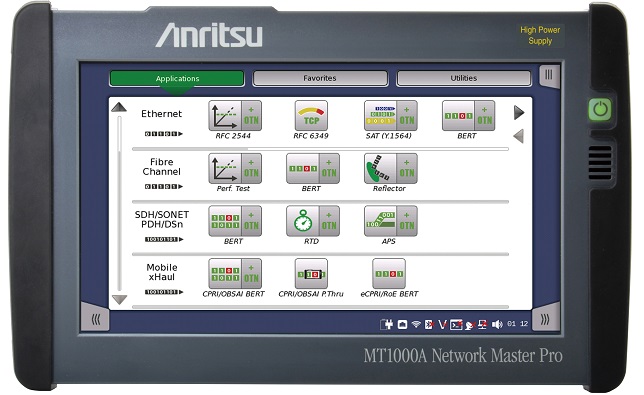Anritsu upgraded Network Master Pro MT1000A Synchronous Measurement Function for 5G Mobile Network I&M

Anritsu Corporation (President Hirokazu Hamada) has announced an upgraded synchronous measurement function for the company’s Network Master Pro MT1000A, the industry’s smallest- in-class tester supporting mobile networks up to 100 Gbps. Fifth-generation (5G) networks are expected to support increasing future numbers of applications and services, such as hi-definition video streaming, autonomous driving, IoT sensing, smart factories, etc. By upgrading this MT1000A test function, Anritsu hopes to facilitate construction of time-synchronous infrastructure, a key technology supporting 5G networks.
New Product Outline
The MU100090B is a GNSS*1 disciplined oscillator supporting GPS, Galileo, GLONASS, Beidou and QZSS. It receives signals from each of these GNSS to output a UTC-traceable reference time signal as well as 10-MHz signals as a time-synchronous, high-accuracy reference timing supplied to the portable MT1000A, supporting SyncE Wander and PTP tests up to 25 Gbps for measuring network time synchronization.
Furthermore, multiple MT1000A testers at various remote sites can be operated and monitored from the central office using the Site Over Remote Access MX109020A (SORA) software to help quickly pinpoint synchronization problems.
[Click for more details of MT1000A.]
Development Background
Deployment of 5G communications networks is spreading due to the advantages of ultra-high speeds, high reliability, low latency, and multiple simultaneous connections in various scenarios. The millimeter-wave (mmWave) band used by 5G technology employs the TDD*2 time-division duplexing technology for managing timing of uplink and downlink signals. This technology requires that the time at all base stations is precisely synchronized, otherwise interference will cause degraded communications quality. Moreover, achieving a “smart” IoT-based society will require cooperation between devices exchanging position information acquired using OTDOA*3 positioning technology, which is ideal for IoT applications, but high-accuracy position measurement is impossible without high-accuracy time synchronization between base stations.
Base stations can be synchronized using wired-network technologies called SyncE*4 and PTP*5, which require both measurement of the network time-synchronization performance when installing and maintaining a cell site, along with guaranteed network performance by the network operator.
Moreover, the O-RAN Alliance*6, which is a mainstream promoter of base-station multivendors, increasingly requires tests of overall mobile network time-synchronization performance to assure interconnectivity.
Time-synchronization quality is indicated by drift from coordinated universal time (UTC*7), so precise time-synchronization measurement requires expensive infrastructure to acquire UTC with high accuracy. This can be a challenge at installation and maintenance of many cell sites.
Anritsu has developed many test instruments for measuring the jitter and wander of transport networks since the SDH/SONET era. Adding this new High Performance GNSS Disciplined Oscillator MU100090B to the line of modules for the portable, battery-operated MT1000A will help simplify on-site I&M time-synchronization tests.
Key Features
- High-accuracy multiband measurement
Interference caused by the ionosphere between the antenna and a satellite is a major cause of noise and inaccuracy. Since the MU100090B can simultaneously receive signals in two frequency bands from GNSS, it can self-correct for these ionospheric errors.
- Convenient on-site support for multiple GNSS
At least four satellites must be visible to capture the reference timing with high accuracy from the GNSS. Adding other national satellite systems in addition to the U.S. GPS greatly improves the accuracy of the captured reference timing. Using the MU100090B with other satellites, such as GLONASS and Galileo, makes it easy to capture a precise reference timing.
- Short warm-up time and high-stability Holdover
Signals from satellites are easily affected by external factors causing extreme short-term instability in timing data. The MU100090B has a function for learning GNSS timings to estimate and output the optimum timing for time-synchronization measurement via the built-in rubidium oscillator.
In comparison to the earlier MU100090A model, a revision of this learning algorithm has cut the warm-up time by more than one-quarter, helping improve the efficiency of measurement work.
Moreover, the Holdover stability is also improved, which is useful for time-synchronization tests at locations where satellites are not visible, such as in underground malls, stadiums, and equipment cabinets.
Target Markets and Applications
Target Markets: Communications operators, network installers, communications equipment vendors
Applications: Installing, maintaining, and troubleshooting communications networks, simple evaluation of communications equipment
Technical Terms
*1 GNSS
Abbreviation for Global Navigation Satellite System; system of manmade global positioning satellites with GPS as one US-operated GNSS. Other national systems are Galileo operated by Europe, GLONASS operated by Russia, Beidou operated by China, and QZSS operated by Japan.
*2 TDD
Abbreviation for Time Division Duplexing; technology for switching up and down communications signals between network and terminal at fixed interval to improve band usage by sharing same frequency band for both transmission and reception.
*3 OTDOA
Abbreviation for Observed Time Difference of Arrival; method for determining own position using received timing difference for terminals receiving signals simultaneously from multiple satellites. Useful for IoT applications because terminals determine own position without imposing network load.
*4 SyncE
Abbreviation for Synchronous Ethernet technology to improve communications quality; ITU-T standard related to frequency synchronization.
*5 PTP
Abbreviation for Precision Time Protocol; IEEE1588v2 protocol for aligning times between equipment with nanosecond-level time-synchronization precision.
*6 O-RAN Alliance
Standards organization created by network operators and communication equipment vendors; aims to promote multivendors for mobile network equipment and flexible expandability by dividing base stations into RU (Radio Unit), DU (Distributed Unit), and CU (Centralized Unit) and publishing open standards between interfaces.
*7 UTC
Abbreviation for Coordinated Universal Time





